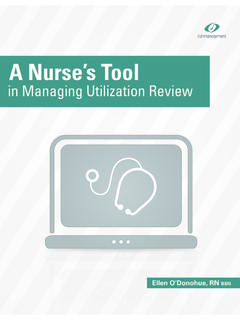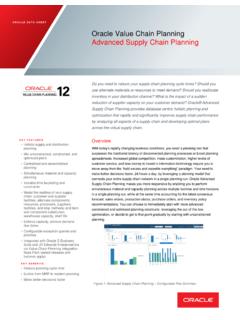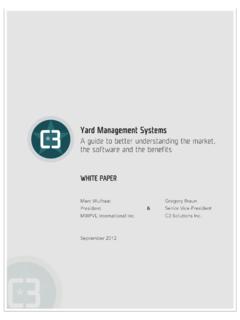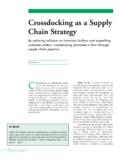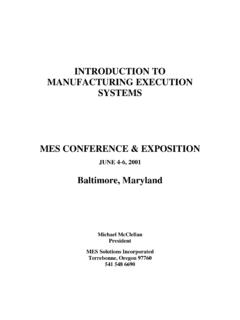Transcription of PROGRAM EVALUATION AND REVIEW …
1 1 PROGRAM EVALUATION AND REVIEW technique (PERT) Category: Planning/ Monitoring - Control AB ST RAC T PROGRAM (Project) EVALUATION and REVIEW technique (PERT)(G) is a project management tool used to schedule, organize, and coordinate tasks within a project. It is basically a method to analyze the tasks involved in completing a given project, especially the time needed to complete each task, and to identify the minimum time needed to complete the total project. PERT planning involves the following steps: Identify the specific activities and milestones. Determine the proper sequence of the activities. Construct a network diagram. Estimate the time required for each activity. Determine the critical path. Update the PERT chart as the project progresses.
2 KEYWORDS PROGRAM EVALUATION and REVIEW technique (PERT), nodes, PERT event, predecessor event, successor event, PERT activity, Optimistic time, Pessimistic time, Most likely time, Expected time, Critical Path, Lead time, Lag time, Slack. OB JEC T I VE The main objective of PERT is to facilitate decision making and to reduce both the time and cost required to complete a project. FI ELD OF APPLI C AT I ON PERT is intended for very large-scale, one-time, non-routine, complex projects with a high degree of intertask dependency, projects which require a series of activities, some of which must be performed sequentially and others that can be performed in parallel with other activities. RELAT ED T OOLS Critical Path Method (CPM), Gantt chart 2 DESC RI PT I ON PERT planning involves the following steps that are described below.
3 1. Identify the specific activities and milestones. The activities are the tasks required to complete a project. The milestones are the events marking the beginning and the end of one or more activities. It is helpful to list the tasks in a table that in later steps can be expanded to include information on sequence and duration. 2. Determine the proper sequence of the activities. This step may be combined with the activity identification step since the activity sequence is evident for some tasks. Other tasks may require more analysis to determine the exact order in which they must be performed. 3. Construct a network diagram. Using the activity sequence information, a network diagram can be drawn showing the sequence of the serial and parallel activities.
4 Each activity represents a node in the network, and the arrows represent the relation between activities. Software packages simplify this step by automatically converting tabular activity information into a network diagram. 4. Estimate the time required for each activity. Weeks are a commonly used unit of time for activity completion, but any consistent unit of time can be used. A distinguishing feature of PERT is its ability to deal with uncertainty in activity completion time. For each activity, the model usually includes three time estimates: Optimistic time generally the shortest time in which the activity can be completed. It is common practice to specify optimistic time to be three standards deviations from the mean so that there is a approximately a 1% chance that the activity will be completed within the optimistic time.
5 Most likely time the completion time having the highest probability. Note that this time is different from the expected time. Pessimistic time the longest time that an activity might require. Three standard deviations from the mean is commonly used for the pessimistic time. PERT assumes a beta probability distribution for the time estimates. For a beta distribution, the expected time for each activity can be approximated using the following weighted average: Expected time = ( Optimistic + 4 x Most likely + Pessimistic ) / 6 This expected time may be displayed on the network diagram. To calculate the variance for each activity completion time, if three standard deviation times were selected for the optimistic and pessimistic times, then there are six standard deviations between them, so the variance is given by: [ ( Pessimistic - Optimistic ) / 6 ] 3 5.
6 Determine the critical path. The critical path is determined by adding the times for the activities in each sequence and determining the longest path in the project. The critical path determines the total calendar time required for the project. If activities outside the critical path speed up oe slow down (within limits), the total project time does not change. The amount of time that a non critical path activity can be delayed without the project is referred to as a slack time. If the critical path is not immediately obvious, it may be helpful to determine the following four quantities foe each activity: ES Earliest Start time EF - Earliest Finish time LS Latest Start time LF - Latest Finish time These times are calculated using the expected time for the relevant activities.
7 The earliest start and finish times of each activity are determined by working forward through the network and determining the earliest time at which an activity can start and finish considering its predecessors activities. The latest start and finish times are the latest times that an activity can start and finish without delaying the project. LS and LF are found by working backward through the network. The difference in the latest and earliest finish of each activity is that activity s slack. The critical path then is the path through the network in which none of the activities have slack. The variance in the project completion time can be calculated by summing the variances in the completion times of the activities in the critical path. Given this variance, one can calculate the probability that the project will be completed by the certain date assuming a normal probability distribution for the critical path.
8 The normal distribution assumption holds if the number of activities in the path is large enough for the central limit theorem to be applied. Since the critical path determines the completion date of the project, the project can be accelerated by adding the resources required to decrease the time for the activities in the critical path. Such a shortening of the project sometimes is referred to as project crashing. Update the PERT chart as the project progresses. Make adjustments in the PERT chart as the project progresses. As the project unfolds, the estimated times can be replaced with actual times. In cases where there are delays, additional resources may be needed to stay on schedule and the PERT chart may be modified to reflect the new situation.
9 B EN EFI T S PERT is useful because it provides the following information: Expected project completion time; Probability of completion before a specified date; 4 The critical path activities that directly impact the completion time; The activities that have slack time and that can be lend resources to critical path activities; Activity start and end date. PREREQUI SI T ES Personnel should already have a good understanding of formal project management terminology, tools, and techniques PERT form template of equivalent tool ( software) Create of project plan Choose the most appropriate scheduling method Select and organize a team to perform project tasks. EX AMPLES C ASE ST U DY In the following example, the Project manager knows the succession of the project activities and the optimistic, pessimistic and most likely time (in weeks) for the following activities: Activity Description Predecessors Optimistic time (0) Pessimistic time (P) Most likely time (M) Expected time (0+4M+P)/6 A Select administrative and medical staff.
10 - 9 15 12 12 B Select site and do site survey. - 5 13 9 9 C Select equipment. A 8 12 10 10 D Prepare final construction plans and layout. B 7 17 9 10 E Bring utilities to the site. B 18 34 23 24 5 F Interview applicants and fill positions in nursing support staff, maintenance, and security. A 9 15 9 10 G Purchase and take delivery of equipment. C 30 40 35 35 H Construct the hospital. D 35 49 39 40 I Develop an information system. A 12 18 15 15 J Install the equipment. E, G, H 3 9 3 4 K Train nurses and support staff F, I, J 7 11 9 9 The associated network is: 6 The earliest start time, earliest finish time, latest start time and latest finish time for each activity are calculated in the following table: Node Duration ES EF LS LF Slack A 12 0 12 2 14 2 BB 99 00 99 00 99 00 C 10 12 22 14 24 2 DD 1100 99 1199 99 1199 00 E 24 9 33 35 59 26 F 10 12 22 53 63 41 G 35 22 57 24 59 2 HH 4400 1199 5599 1199 5599 00 I 15 12 27 48 63 36 JJ 44 5599 6633 5599 6633 00 KK 66 6633 7722 6633 7722 00 7 Critical Path F 10 12 22 53 63 Activity name Earliest finish time Latest finish time Expected time Latest start time Earliest start time 8 B I B LI OGRAPHY 1.


